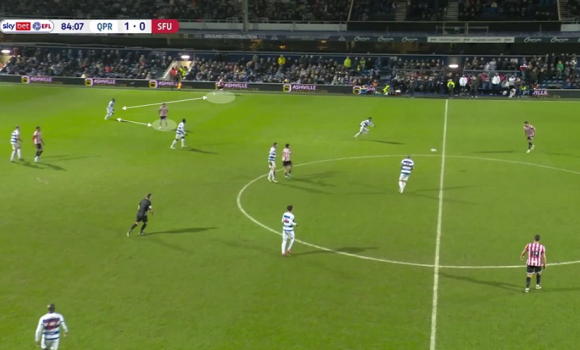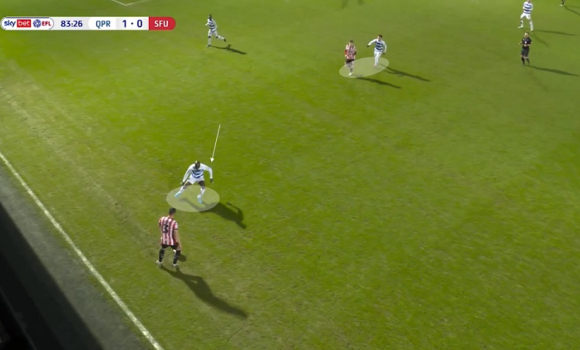Critchley’s positive adjustments v Sheff Utd — Analysis Thursday, 12th Jan 2023 21:33 by Dan Lambert Prior to Saturday’s disaster at Fleetwood, QPR had shown marked improvement in the home draw against high flying Sheffield United — Dan Lambert examines what new manager Neil Critchley has tried to do with his struggling new side. Four league games have taken place under new head coach Neil Critchley and they have provided us with a mixed bag of performances and results. The most recent league performance, against Sheffield United, was the best yet from a tactical point of view. ApproachesNeil Critchley set Rangers up in a 4-3-2-1, with the return of Ilias Chair and Chris Willock to the side for the first time since Coventry away and Tyler Roberts joining them in the front three behind Lyndon Dykes. With the front four starting collectively it signalled aggression both in and out of possession to go man to man against their back three whilst protecting Olly Norwood as the pivot. Sheff Utd lined up in a 3-5-2 shape with a real emphasis on pushing the wing backs right onto the last line to overload QPR’s backline.
Pressing and counter-pressingSomething Neil Critchley emphasised post-match was the quality of Rangers’ pressing when Sheff Utd had the ball, but also the intensity to counter-press the opposition immediately after losing possession to create turnovers in high areas of the pitch to hit Sheff Utd on the counter attack. Starting with the pressing, it certainly stifled Sheffield Utd when building up cleanly, usually forcing them backwards or long to Ndiaye and Billy Sharp.
I spoke earlier about the use of the front four indicating aggression both in and out of possession in preventing Sheff Utd deep build-up and the four in tandem worked well despite certain personnel being ‘loose pressers’ at times.
As shown in the recent example, Field is also high and in close proximity to the front four. With the aggression and intensity of the front four out of possession, the distances need to be short enough between the attack and midfield to maintain the mid to high press otherwise clearer spaces appear for teams to break lines quicker and with more ease.
As well as showing the press being effective, the counter-pressing and intensity of the counter-press helped create sustained territory inside Sheffield Utd’s half.
The distances of the front four out of possession were pleasing, and this in fact helped to score our goal early on in the game, crowding an area that Sheff Utd tried to play through, forcing the turnover and having a shot on goal.
Overloading with widthWhilst we’re yet to see any real clear patterns of play under Critchley, one difference between his and Beale’s system is the use of width. A wider back four system used, and a common theme with this game was using runners not only to support attacks but overload certain wide spaces.
What we did see in the first half, as we normally see with this side this season, was a lot of left sided dominance, with Chair, Willock and Paal combining to create attacks.
Both full backs offered support through off ball runs during the game, but there was an emphasis for Kakay to provide height down the right side as there wasn’t a natural right sided presence like Shodipo provided against Luton as a more orthodox 1v1 winger.
The desire of these overlaps along with the off-ball runs towards the box to support and create attacks are promising. They’re something we seriously lacked before the World Cup break when I did a piece on our issues going forward and breaking down set defences. Direct play within possessionLyndon Dykes gave a brilliant performance against Sheffield United. His link play, back-to-goal and the high number of first and second contacts he won helped Rangers secure sustained periods of territory within Sheff Utd’s half. Sheff Utd when pressing aggressively would be able to go man to man due to their shape, therefore when they left spaces it was effective for Rangers to attack those spaces, or utilise Dykes by playing over the first two lines of their press and into him instead.
As well as using Dykes to win first contacts and win flick-ons to create territory within Sheff Utd’s half, it was important to sustain the territory by getting the midfield’s distances right.
It’s no surprise to see the subtle difference in moving the front three 5/10 yards closer to Dykes to support him when going direct has on the structure of the team in order to gain territory, but also win second balls and create sustained territory. This was a stark difference to the Luton game where Dykes was isolated for huge swathes of the game when utilised in the build-up and Luton had a field day with constant attacks in our half and were comfortable playing aggressive and high. In game tweaksThis is the first game we’ve been able to see real tactical flexibility from Critchley’s in-game management. It’s worth mentioning that, firstly, Sheffield United changed their shape at half time with Heckingbottom opting for a 4-4-2 diamond from the original 3-5-2 shape. Berge and Mcatee played as outside midfielders in the diamond, Norwood at the base, Ndiaye at the tip. That caused Rangers some problems initially - the 4v3 in midfield being the main one, allowing the visitors to seize control of the game and give Sheff Utd a chance to get back in the game. Critchley reacted to this and went to a 4-3-3 in possession and a 4-5-1 out of possession.
Critchley brought on Amos to make it three CMs and to make it a bank of five across the second line. He also brought Adomah on to fill the RM spot, with our midfield line between a RM and RWB role depending on the height of our defensive shape. I’ve seen people question the subs and question the tactical change to drop deeper and go to a 4-5-1 but I’ll try and explain why Critchley’s tweaks nullified Sheff Utd as well as they could, and the impact of dropping deeper. When Sheffield Utd went to the diamond, they naturally lost some width to play around our shape. The outside midfielders needed to play wider and higher to pin our shape, but also to create some positional overloads.
Although Iroegbunam is the deepest midfielder closest to Berge, the midfield line behind Dykes is a bit too aggressive, leaving spaces for Sheffield Utd to manipulate, therefore there was a need to sit deeper to protect and control the central spaces to prevent the diamond from having its desired impact.
As mentioned previously, we set up in a 4-5-1 out of possession in the last 20 minutes in a mid to low block to compress spaces and force Sheff Utd around our shape. This in turn forces them to empty their midfield and obviously we hope this means an opportunity would fall for QPR to hit them on the counter.
Final thoughtsAll in all the performance from Critchley’s side was very good and much improved from the game against Luton. Tactically, I thought Critchley was near enough spot on, his tweaks helped nullify Sheff Utd’s new threats, they failed to register many clear cut chances due to our structure and we improved in the aspect of winning second balls and sustaining territory. Yes, we did concede, but it was a rather unfortunate goal. We are still lacking consistency in creating chances with quality and quantity from the first four games, but defensively, bar Luton, we have improved. The distances when defending are better, we’re giving less spaces for opponents to attack and our structure (which Critchley has worked on) is generally improved. A lack of time on the training ground across the congested schedule is a correlation with the minimal tweaks made under Critchley so far, but with the one game weeks to come in January and February, hopefully there are bigger and more clearer improvements that he is able to make. Note - this piece was written prior to the disastrous performance and result against Fleetwood on Saturday. Everything I’ve said in relation to the Sheff Utd game still stands, the Blades game is now the bar to reach consistently, and as Critchley said post Fleetwood our inconsistency in performances are a big issue. Links >>> More like this at Dan’s SubStack >>> What have we learned so far? >>> QPR’s attacking set pieces If you enjoy LoftforWords, please consider supporting the site through a subscription to our Patreon or tip us via our PayPal account loftforwords@yahoo.co.uk. Pictures — QPRPlusPass The Twitter @DanLambert__ Ian Randall Photography Please report offensive, libellous or inappropriate posts by using the links provided.
You need to login in order to post your comments |
Blogs 31 bloggersLeyton Orient Polls |



























